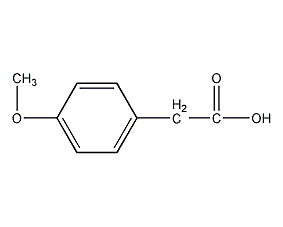
Structural formula
| Business number | 02PL |
|---|---|
| Molecular formula | C9H10O3 |
| Molecular weight | 166.17 |
| label |
4-Methoxyphenylacetic acid, p-Methoxyphenylacetic acid, 4-Methoxyphenylacetic acid, Asischem d13364, Labotest-bb lt00848110, Homoanisic acid, 4-Methoxyphenylacetic acid, p-Methoxy-a-carboxytoluene, p-Methoxyphenylacetic acid, Rarechem al bo 0133 |
Numbering system
CAS number:104-01-8
MDL number:MFCD00004345
EINECS number:203-166-4
RTECS number:AI8960000
BRN number:1101737
PubChem ID:None
Physical property data
1. Appearance: White flaky crystal
2. Density (g/mL, 20℃): Undetermined
3. Relative vapor density (g/mL, air =1): Undetermined
4. Melting point (ºC): 84-86
5. Boiling point (ºC, normal pressure): Undetermined
6 . Boiling point (ºC, 3mmHg): 140
7. Refractive index: Undetermined
8. Flash point (ºC): 193
9. Specific rotation Degree (º): Undetermined
10. Autoignition point or ignition temperature (ºC): Undetermined
11. Vapor pressure (mmHg, 20.2ºC): Undetermined
p>
12. Saturated vapor pressure (kPa, ºC): Undetermined
13. Heat of combustion (KJ/mol): Undetermined
14. Critical temperature (ºC ): Undetermined
15. Critical pressure (KPa): Undetermined
16. Log value of oil-water (octanol/water) partition coefficient: Undetermined
17. Explosion upper limit (%, V/V): Undetermined
18. Explosion lower limit (%, V/V): Undetermined
19. Solubility: Easy Soluble in ethanol, soluble in ether, insoluble in water.
Toxicological data
1. Skin/eye irritation: Standard Dresser test: rabbit eye contact, 100mgREACTION SEVERITY, strong reaction; 2. Acute toxicity: rat oral LD50: 1550mg/kg; mouse peritoneal cavity LD50: 504mg/kg; 3 , Chronic toxicity/carcinogenicity: Mouse oral TDLo: 63mg/kg/78W-I;
Ecological data
This substance is slightly hazardous to water.
Molecular structure data
1. Molar refractive index: 44.04
2.Molar volume (cm3/mol): 140.8
3. Isotonic specific volume (90.2K): 362.3
4. Surface tension (dyne/cm) : 43.7
5. Dielectric constant:
6. Dipole moment (10-24cm3):
7. Polarizability: 17.46
Compute chemical data
1. Reference value for hydrophobic parameter calculation (XlogP): None
2. Number of hydrogen bond donors: 1
3. Number of hydrogen bond acceptors: 3
4. Number of rotatable chemical bonds: 3
5. Number of tautomers: none
6. Topological molecule polar surface area 46.5
7. Number of heavy atoms: 12
8. Surface charge: 0
9. Complexity: 148
10. Number of isotope atoms: 0
11. Determine the number of atomic stereocenters: 0
12. Uncertain number of atomic stereocenters: 0
13. Determine the number of chemical bond stereocenters: 0
14. Number of uncertain chemical bond stereocenters: 0
15. Number of covalent bond units: 1
Properties and stability
Avoid contact with oxides.
Storage method
Store in a cool, ventilated warehouse. Keep away from fire and heat sources. Keep container tightly sealed. should be kept away from oxidizer, do not store together. Equipped with the appropriate variety and quantity of fire equipment. Suitable materials should be available in the storage area to contain spills.
Synthesis method
Prepared from p-methoxyacetophenone as raw material. Add ethanol, sulfur and piperazine hexahydrate into the reaction pot and reflux for 4 hours, then evaporate the ethanol. The obtained sulfide piperazine was reacted with p-methoxyacetophenone at 135-140°C for 20 hours, and then sodium hydroxide was added and refluxed for 20 hours. After the reaction is completed, cool to below 35°C and adjust the pH value to 8-9 with hydrochloric acid. After separating the sulfur with a centrifuge, neutralize it until the pH value is 3-4, cool it, and dehydrate it by centrifugation. The resulting crude product is refined to obtain p-methoxyphenylacetic acid.
Purpose
Used in organic synthesis as an intermediate of puerarin.

 微信扫一扫打赏
微信扫一扫打赏

